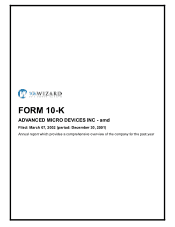AMD 2001 Annual Report Download - page 10
Download and view the complete annual report
Please find page 10 of the 2001 AMD annual report below. You can navigate through the pages in the report by either clicking on the pages listed below, or by using the keyword search tool below to find specific information within the annual report. Maintaining PC processor sales levels in 2002 depends on a continuing
successful technology transition in our manufacturing facility located in
Dresden, Germany (Dresden Fab 30), our ability to maintain average selling
prices for our seventh-generation microprocessors, continuing growth in unit
shipments of our PC processors, and increasing market acceptance of the newest
versions of the AMD Athlon and AMD Duron microprocessors.
We plan to continue to make significant capital expenditures to support our
microprocessor and Flash memory products both in the near and long term. Our
ability to increase microprocessor product revenues and benefit fully from the
substantial investments we have made and continue to make related to
microprocessors, depends upon the continuing success of our seventh-generation
and future generations of microprocessors, beginning with the eighth-generation
family of microprocessors code-named "Hammer," that we currently plan to
introduce at the end of 2002. The Hammer microprocessors will be our first PC
processors capable of 64-bit operation and are being designed to deliver
leading-edge performance on both the 64-bit software used by high-end
workstations and servers and the 32-bit software used by the majority of
desktop users.
The microprocessor market is characterized by short product life cycles and
migration to ever-higher performance microprocessors. To compete successfully
against Intel in this market, we must transition to new process technologies at
a fast pace and offer higher performance microprocessors in significantly
greater volumes. We also must achieve yield and volume goals while producing
these higher performance microprocessors in order to offer these products at
competitive prices.
Intel has dominated the market for microprocessors used in PCs for many
years. As a result, Intel has been able to control x86 microprocessor and PC
system standards and dictate the type of products the market requires of
Intel's competitors. In addition, the financial strength of Intel allows it to
market its products aggressively, target our customers and our channel partners
with special incentives and discipline customers who do business with us. These
aggressive activities can result in lower average selling prices for us and
adversely affect our margins and profitability. Intel also exerts substantial
influence over PC manufacturers and their channels of distribution through the
"Intel Inside" brand and other marketing programs. As long as Intel remains in
this dominant position, we may be materially and adversely affected by its:
. pricing and allocation strategies;
. product mix and introduction schedules;
. product bundling, marketing and merchandising strategies;
. control over industry standards, PC manufacturers and other PC industry
participants, including motherboard, chipset and basic input/output system
(BIOS) suppliers; and
. user brand loyalty.
We expect Intel to maintain its dominant position in the marketplace as well as
to continue to invest heavily in research and development, new manufacturing
facilities and other technology companies.
Intel also dominates the PC system platform. As a result, PC OEMs are highly
dependent on Intel, less innovative on their own and, to a large extent,
distributors of Intel technology. In marketing our microprocessors to these
OEMs and dealers, we depend on companies other than Intel for the design and
manufacture of core-logic chipsets, graphics chips, motherboards, BIOS software
and other components. In recent years, many of these third-party designers and
manufacturers have lost significant market share or exited the business. In
addition, these companies produce chipsets, motherboards, BIOS software and
other components to support each new generation of Intel's microprocessors, and
Intel has significant leverage over their business opportunities.
To compete with Intel in the microprocessor market in the future, we intend
to continue to form close relationships with third-party designers and
manufacturers of chipsets, motherboards, graphics chips, BIOS software and
other components. Similarly, we intend to expand our chipset and system design
capabilities and to offer OEMs licensed system designs incorporating our
processors and companion products. We cannot be certain, however, that our
efforts will be successful.
6
Source: ADVANCED MICRO DEVIC, 10-K, March 07, 2002























